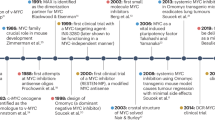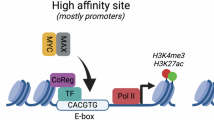Abstract
The MYC oncogene is frequently overexpressed in tumors and inhibition of its translation is considered an attractive therapeutic opportunity. Despite numerous reports proposing an internal ribosome entry site (IRES) within the MYC Upstream Region (MYC UR) to sustain MYC translation during cellular stress or chemotherapy, conflicting evidence remains regarding the validity of such a mechanism. Through comprehensive investigations in MYC-driven Colorectal Cancer (CRC) and Burkitt Lymphoma (BL) cells, we demonstrate that MYC UR does not facilitate cap-independent translation, but instead orchestrates resistance to PI3K inhibitors. Genomic deletion of MYC UR neither impacts MYC protein levels nor viability in CRC cells, either untreated or exposed to cellular stress. However, in response to PI3K inhibitors, MYC UR drives a FOXO3a-dependent transcriptional upregulation of MYC, conferring drug resistance. This resistance is mediated by enhanced autophagic flux, governed by MYC, and blockade of autophagy sensitizes CRC cells to PI3K inhibition in vitro and in vivo. Remarkably, BL cells lacking the translocation of MYC UR exhibit sensitivity to PI3K inhibitors, whereas MYC UR-translocated cells respond to these drugs only when autophagy is inhibited. These findings challenge previous notions regarding IRES-mediated translation and highlight a promising strategy to overcome resistance to PI3K inhibitors in MYC-driven malignancies, offering potential clinical implications for CRC and BL treatment.

In response to BKM120, the upstream region of MYC (UR) enhances MYC expression, via FOXO3a, leading to increased autophagic flux and resistance to PI3K inhibitors (left). Pharmacological blockade of autophagy (center) or lack of translocated MYC UR along with MYC CDS in BL (right) overcome resistance and induces cells death. Image created in BioRender.
This is a preview of subscription content, access via your institution
Access options
Subscribe to this journal
Receive 50 print issues and online access
269,00 € per year
only 5,38 € per issue
Buy this article
- Purchase on SpringerLink
- Instant access to full article PDF
Prices may be subject to local taxes which are calculated during checkout







Similar content being viewed by others
Data availability
All data generated during and/or analyzed during the current study are available from the corresponding author on reasonable request.
References
Dang CV, O’Donnell KA, Zeller KI, Nguyen T, Osthus RC, Li F. The c-Myc target gene network. Semin Cancer Biol. 2006;16:253–64.
ar-Rushdi A, Nishikura K, Erikson J, Watt R, Rovera G, Croce CM. Differential expression of the translocated and the untranslocated c-myc oncogene in Burkitt lymphoma. Science. 1983;222:390–3.
Dalla-Favera R, Bregni M, Erikson J, Patterson D, Gallo RC, Croce CM. Human c-myc onc gene is located on the region of chromosome 8 that is translocated in Burkitt lymphoma cells. Proc Natl Acad Sci USA. 1982;79:7824–7.
Taub R, Kirsch I, Morton C, Lenoir G, Swan D, Tronick S, et al. Translocation of the c-myc gene into the immunoglobulin heavy chain locus in human Burkitt lymphoma and murine plasmacytoma cells. Proc Natl Acad Sci USA. 1982;79:7837–41.
Rabbitts TH, Hamlyn PH, Baer R. Altered nucleotide sequences of a translocated c-myc gene in Burkitt lymphoma. Nature. 1983;306:760–5.
Pelengaris S, Khan M, Evan G. c-MYC: more than just a matter of life and death. Nat Rev Cancer. 2002;2:764–76.
Lee KS, Kwak Y, Nam KH, Kim DW, Kang SB, Choe G, et al. c-MYC copy-number gain is an independent prognostic factor in patients with colorectal cancer. PLoS One. 2015;10:e0139727.
Kakisako K, Miyahara M, Uchino S, Adachi Y, Kitano S. Prognostic significance of c-myc mRNA expression assessed by semi-quantitative RT-PCR in patients with colorectal cancer. Oncol Rep. 1998;5:441–5.
Bhatavdekar JM, Patel DD, Ghosh N, Chikhlikar PR, Trivedi TI, Suthar TP, et al. Coexpression of Bcl-2, c-Myc, and p53 oncoproteins as prognostic discriminants in patients with colorectal carcinoma. Dis Colon Rectum. 1997;40:785–90.
Rowley S, Newbold KM, Gearty J, Keighley MR, Donovan IA, Neoptolemos JP. Comparison of deoxyribonucleic acid ploidy and nuclear expressed p62 c-myc oncogene in the prognosis of colorectal cancer. World J Surg. 1990;14:545–50. discussion 551
Wang C, Zhang J, Yin J, Gan Y, Xu S, Gu Y, et al. Alternative approaches to target Myc for cancer treatment. Sig Transduct Target Ther. 2021;6:1–14.
Struntz NB, Chen A, Deutzmann A, Wilson RM, Stefan E, Evans HL, et al. Stabilization of the max homodimer with a small molecule attenuates Myc-driven transcription. Cell Chem Biol. 2019;26:711–23.e14.
Llombart V, Mansour MR. Therapeutic targeting of “undruggable” MYC. EBioMedicine 2021;75:103756.
Whitfield JR, Beaulieu ME, Soucek L. Strategies to inhibit Myc and their clinical applicability. Front Cell Dev Biol [Internet]. 2017;5. [cited 2024 Feb 17]. Available from: https://www.frontiersin.org/articles/10.3389/fcell.2017.00010
De Benedetti A, Graff JR. eIF-4E expression and its role in malignancies and metastases. Oncogene. 2004;23:3189–99.
Shi Y, Sharma A, Wu H, Lichtenstein A, Gera J. Cyclin D1 and c-myc internal ribosome entry site (IRES)-dependent translation is regulated by AKT activity and enhanced by rapamycin through a p38 MAPK- and ERK-dependent pathway*. J Biol Chem. 2005;280:10964–73.
Nanbru C, Lafon I, Audigier S, Gensac MC, Vagner S, Huez G, et al. Alternative translation of the proto-oncogene c-myc by an internal ribosome entry site. J Biol Chem. 1997;272:32061–6.
Stoneley M, Paulin FE, Quesne JPL, Chappell SA, Willis AE. C-Myc 5′ untranslated region contains an internal ribosome entry segment. Oncogene. 1998;16:423–8.
Walsh D, Mathews MB, Mohr I. Tinkering with translation: protein synthesis in virus-infected cells. Cold Spring Harb Perspect Biol. 2013;5:a012351.
Pelletier J, Sonenberg N. Internal initiation of translation of eukaryotic mRNA directed by a sequence derived from poliovirus RNA. Nature. 1988;334:320–5.
Jang SK, Kräusslich HG, Nicklin MJ, Duke GM, Palmenberg AC, Wimmer E. A segment of the 5’ nontranslated region of encephalomyocarditis virus RNA directs internal entry of ribosomes during in vitro translation. J Virol. 1988;62:2636–43.
Komar AA, Hatzoglou M. Cellular IRES-mediated translation. Cell Cycle. 2011;10:229–40.
Subkhankulova T, Mitchell SA, Willis AE. Internal ribosome entry segment-mediated initiation of c-Myc protein synthesis following genotoxic stress. Biochem J. 2001;359:183–92.
Stoneley M, Chappell SA, Jopling CL, Dickens M, MacFarlane M, Willis AE. c-Myc protein synthesis is initiated from the internal ribosome entry segment during apoptosis. Mol Cell Biol. 2000;20:1162–9.
Yeh DW, Zhao X, Siddique HR, Zheng M, Choi HY, Machida T, et al. MSI2 promotes translation of multiple IRES-containing oncogenes and virus to induce self-renewal of tumor initiating stem-like cells. Cell Death Discov. 2023;9:1–15.
Grentzmann G, Ingram JA, Kelly PJ, Gesteland RF, Atkins JF. A dual-luciferase reporter system for studying recoding signals. RNA. 1998;4:479–86.
Kozak M. New Ways of Initiating Translation in Eukaryotes? Mol Cell Biol. 2001;21:1899–907.
Hellen CUT, Sarnow P. Internal ribosome entry sites in eukaryotic mRNA molecules. Genes Dev. 2001;15:1593–612.
Bert AG, Grépin R, Vadas MA, Goodall GJ. Assessing IRES activity in the HIF-1α and other cellular 5′ UTRs. RNA. 2006;12:1074–83.
Baranick BT, Lemp NA, Nagashima J, Hiraoka K, Kasahara N, Logg CR. Splicing mediates the activity of four putative cellular internal ribosome entry sites. Proc Natl Acad Sci USA. 2008;105:4733–8.
Wang Z, Weaver M, Magnuson NS. Cryptic promoter activity in the DNA sequence corresponding to the pim-1 5’-UTR. Nucleic Acids Res. 2005;33:2248–58.
Van Eden ME, Byrd MP, Sherrill KW, Lloyd RE. Demonstrating internal ribosome entry sites in eukaryotic mRNAs using stringent RNA test procedures. RNA. 2004;10:720–30.
Shi Y, Yang Y, Hoang B, Bardeleben C, Holmes B, Gera J, et al. Therapeutic potential of targeting IRES-dependent c-myc translation in multiple myeloma cells during ER stress. Oncogene. 2016;35:1015–24.
Denk S, Schmidt S, Schurr Y, Schwarz G, Schote F, Diefenbacher M, et al. CIP2A regulates MYC translation (via its 5′UTR) in colorectal cancer. Int J Colorectal Dis. 2021;36:911–8.
Martinez-Useros J, Garcia-Carbonero N, Li W, Fernandez-Aceñero MJ, Cristobal I, Rincon R, et al. UNR/CSDE1 expression is critical to maintain invasive phenotype of colorectal cancer through regulation of c-MYC and epithelial-to-mesenchymal transition. J Clin Med. 2019;8:560.
Spriggs KA, Cobbold LC, Jopling CL, Cooper RE, Wilson LA, Stoneley M, et al. Canonical initiation factor requirements of the myc family of internal ribosome entry segments. Mol Cell Biol. 2009;29:1565–74.
Wiegering A, Uthe FW, Jamieson T, Ruoss Y, Hüttenrauch M, Küspert M, et al. Targeting translation initiation bypasses signaling crosstalk mechanisms that maintain high MYC levels in colorectal cancer. Cancer Discov. 2015;5:768–81.
Thoreen CC, Chantranupong L, Keys HR, Wang T, Gray NS, Sabatini DM. A unifying model for mTORC1-mediated regulation of mRNA translation. Nature. 2012;485:109–13.
Pyronnet S, Pradayrol L, Sonenberg N. A cell cycle-dependent internal ribosome entry site. Mol Cell. 2000;5:607–16.
Shi Y, Sun F, Cheng Y, Holmes B, Dhakal B, Gera JF, et al. Critical role for cap-independent c-MYC translation in progression of multiple myeloma. Mol Cancer Therapeutics. 2022;21:502–10.
Karar J, Cerniglia GJ, Lindsten T, Koumenis C, Maity A. Dual PI3K/mTOR inhibitor NVP-BEZ235 suppresses hypoxia-inducible factor (HIF)-1α expression by blocking protein translation and increases cell death under hypoxia. Cancer Biol Ther. 2012;13:1102–11.
Burger MT, Pecchi S, Wagman A, Ni ZJ, Knapp M, Hendrickson T, et al. Identification of NVP-BKM120 as a potent, selective, orally bioavailable class I PI3 kinase inhibitor for treating cancer. ACS Med Chem Lett. 2011;2:774–9.
Ilic N, Utermark T, Widlund HR, Roberts TM. PI3K-targeted therapy can be evaded by gene amplification along the MYC-eukaryotic translation initiation factor 4E (eIF4E) axis. Proc Natl Acad Sci USA. 2011;108:E699–708.
Wright CJM, McCormack PL. Trametinib: first global approval. Drugs. 2013;73:1245–54.
Liu J, Long S, Wang H, Liu N, Zhang C, Zhang L, et al. Blocking AMPK/ULK1-dependent autophagy promoted apoptosis and suppressed colon cancer growth. Cancer Cell Int. 2019;19:336.
Degenhardt K, Mathew R, Beaudoin B, Bray K, Anderson D, Chen G, et al. Autophagy promotes tumor cell survival and restricts necrosis, inflammation, and tumorigenesis. Cancer Cell. 2006;10:51–64.
Yang W, Hosford SR, Traphagen NA, Shee K, Demidenko E, Liu S, et al. Autophagy promotes escape from phosphatidylinositol 3-kinase inhibition in estrogen receptor–positive breast cancer. FASEB J. 2018;32:1222–35.
Ren H, Guo H, Thakur A, Zhang S, Wang T, Liang Y, et al. Blockade efficacy of MEK/ERK-dependent autophagy enhances PI3K/Akt inhibitor NVP-BKM120’s therapeutic effectiveness in lung cancer cells. Oncotarget. 2016;7:67277–87.
Pankiv S, Clausen TH, Lamark T, Brech A, Bruun JA, Outzen H, et al. p62/SQSTM1 binds directly to Atg8/LC3 to facilitate degradation of ubiquitinated protein aggregates by autophagy *. J Biol Chem. 2007;282:24131–45.
Bjørkøy G, Lamark T, Pankiv S, Øvervatn A, Brech A, Johansen T. Monitoring autophagic degradation of p62/SQSTM1. Methods Enzymol. 2009;452:181–97.
Annunziata I, van de Vlekkert D, Wolf E, Finkelstein D, Neale G, Machado E, et al. MYC competes with MiT/TFE in regulating lysosomal biogenesis and autophagy through an epigenetic rheostat. Nat Commun. 2019;10:3623.
Mangiapane LR, Nicotra A, Turdo A, Gaggianesi M, Bianca P, Di Franco S, et al. PI3K-driven HER2 expression is a potential therapeutic target in colorectal cancer stem cells. Gut. 2022;71:119–28.
López C, Burkhardt B, Chan JKC, Leoncini L, Mbulaiteye SM, Ogwang MD, et al. Burkitt lymphoma. Nat Rev Dis Prim. 2022;8:1–26.
Shiramizu B, Magrath I. Localization of breakpoints by polymerase chain reactions in Burkitt’s lymphoma with 8;14 translocations. Blood. 1990;75:1848–52.
Basso K, Frascella E, Zanesco L, Rosolen A. Improved long-distance polymerase chain reaction for the detection of t(8;14)(q24;q32) in Burkitt’s lymphomas. Am J Pathol. 1999;155:1479–85.
Papadatos-Pastos D, Rabbie R, Ross P, Sarker D. The role of the PI3K pathway in colorectal cancer. Crit Rev Oncol Hematol. 2015;94:18–30.
Zhu M, Jin Q, Xin Y. Recent clinical advances in PI3K inhibitors on colorectal cancer. Pharmazie 2021;76:568–73.
Mele L, Del Vecchio V, Liccardo D, Prisco C, Schwerdtfeger M, Robinson N, et al. The role of autophagy in resistance to targeted therapies. Cancer Treat Rev. 2020;88:102043.
Chang H, Zou Z. Targeting autophagy to overcome drug resistance: further developments. J Hematol Oncol. 2020;13:159.
Toh PPC, Luo S, Menzies FM, Raskó T, Wanker EE, Rubinsztein DC. Myc inhibition impairs autophagosome formation. Hum Mol Genet. 2013;22:5237–48.
Swerdlow SH, Campo E, Harris NL, Jaffe ES, Pileri SA, Stein H, et al. WHO classification of tumours of haematopoietic and lymphoid tissues. Revised 4th edition. Lyon: International Agency for Research on Cancer; 2017. 585 p. (World Health Organization classification of tumours).
Kim H, Park ES, Lee SH, Koo HH, Kim HS, Lyu CJ, et al. Clinical outcome of relapsed or refractory burkitt lymphoma and mature B-cell lymphoblastic leukemia in children and adolescents. Cancer Res Treat. 2014;46:358–65.
Patte C, Auperin A, Michon J, Behrendt H, Leverger G, Frappaz D, et al. The Société Française d’Oncologie Pédiatrique LMB89 protocol: highly effective multiagent chemotherapy tailored to the tumor burden and initial response in 561 unselected children with B-cell lymphomas and L3 leukemia. Blood. 2001;97:3370–9.
Möker P, zur Stadt U, Zimmermann M, Alawi M, Mueller S, Finger J, et al. Characterization of IG-MYC-breakpoints and their application for quantitative minimal disease monitoring in high-risk pediatric Burkitt-lymphoma and. Leukemia. 2022;36:2343–6.
Busch K, Keller T, Fuchs U, Yeh RF, Harbott J, Klose I, et al. Identification of two distinct MYC breakpoint clusters and their association with various IGH breakpoint regions in the t(8;14) translocations in sporadic Burkitt-lymphoma. Leukemia. 2007;21:1739–51.
Coni S, Serrao SM, Yurtsever ZN, Di Magno L, Bordone R, Bertani C, et al. Blockade of EIF5A hypusination limits colorectal cancer growth by inhibiting MYC elongation. Cell Death Dis. 2020;11:1–14.
Coni S, Falconio FA, Marzullo M, Munafò M, Zuliani B, Mosti F, et al. Translational control of polyamine metabolism by CNBP is required for Drosophila locomotor function. Ramaswami M, VijayRaghavan K, Ramaswami M, editors. eLife. 2021;10:e69269.
Coni S, Bordone R, Ivy DM, Yurtsever ZN, Di Magno L, D’Amico R, et al. Combined inhibition of polyamine metabolism and eIF5A hypusination suppresses colorectal cancer growth through a converging effect on MYC translation. Cancer Lett. 2023;559:216120.
D’Amico D, Antonucci L, Di Magno L, Coni S, Sdruscia G, Macone A, et al. Non-canonical Hedgehog/AMPK-mediated control of polyamine metabolism supports neuronal and medulloblastoma cell growth. Dev Cell. 2015;35:21–35.
Di Magno L, Manni S, Di Pastena F, Coni S, Macone A, Cairoli S, et al. Phenformin Inhibits Hedgehog-dependent tumor growth through a complex I-independent redox/corepressor module. Cell Rep. 2020;30:1735–1752.e7.
Xue X, Shah YM. In vitro organoid culture of primary mouse colon tumors. JoVE (J Visualized Exp). 2013;75:e50210.
Acknowledgements
We thank Drs Pankaj Trivedi and Eleni Anastasiadou for sharing Raji and DG75 cells and advice, and Drs Cristiano Simone and Martina Lepore Signorile for providing FOXO3a expression vector and antibody. This work was funded by the Fondazione AIRC (Associazione Italiana per la Ricerca sul Cancro) IG 25833 to GC, IG20801 to LuDM, IG24329 to GG, AIRC Italy Post-Doc fellowship (to RB), MIUR PRIN 2022 2022L332YR (GC), MIUR PRIN 2022 under 40 2022J8X7PJ (SC) Sapienza University of Rome RG12117A61923A6F (GC), Institute Pasteur Italy—Fondazione Cenci Bolognetti, call 2020 “Anna Tramontano” (GC), Fondazione Umberto Veronesi fellowship (to LDM), Dipartimenti di Eccellenza 2018-2022 and 2023-2027 (L. 232/2016).
Author information
Authors and Affiliations
Contributions
GC conceived and coordinated the project, designed experiments, analyzed data and wrote the paper, RB and DMI designed and performed experiments, analyzed data, and wrote the paper, RDA, MB, FDP, BC, FB, AB, MG performed experiments and analyzed data, EDS, GG, LuDM, AF, LDM, SC, GS analyzed data and reviewed the manuscript.
Corresponding author
Ethics declarations
Competing interests
The authors declare no competing interests.
Ethics approval and consent to participate
All methods involving human derived materials and animal subjects were performed in accordance with the relevant local regulation and guidelines. All mouse experiments were performed according to the European Community Council Directive 2010/63/EU and carried out under the approval of the Institutional Animal Care Committee and Ministry of Health (protocol n. C1368.26). Patient-derived colorectal cancer stem cells were obtained in accordance with the ethical standards regarding Human Experimentation and informed consent was obtained from each patient in this study under Institutional Review Board protocols (authorization CE9/2015, Policlinico Paolo Giaccone, Palermo, Italy).
Additional information
Publisher’s note Springer Nature remains neutral with regard to jurisdictional claims in published maps and institutional affiliations.
Supplementary information
Rights and permissions
Springer Nature or its licensor (e.g. a society or other partner) holds exclusive rights to this article under a publishing agreement with the author(s) or other rightsholder(s); author self-archiving of the accepted manuscript version of this article is solely governed by the terms of such publishing agreement and applicable law.
About this article
Cite this article
Bordone, R., Ivy, D.M., D’Amico, R. et al. MYC upstream region orchestrates resistance to PI3K inhibitors in cancer cells through FOXO3a-mediated autophagic adaptation. Oncogene 43, 3349–3365 (2024). https://doi.org/10.1038/s41388-024-03170-6
Received:
Revised:
Accepted:
Published:
Issue Date:
DOI: https://doi.org/10.1038/s41388-024-03170-6



